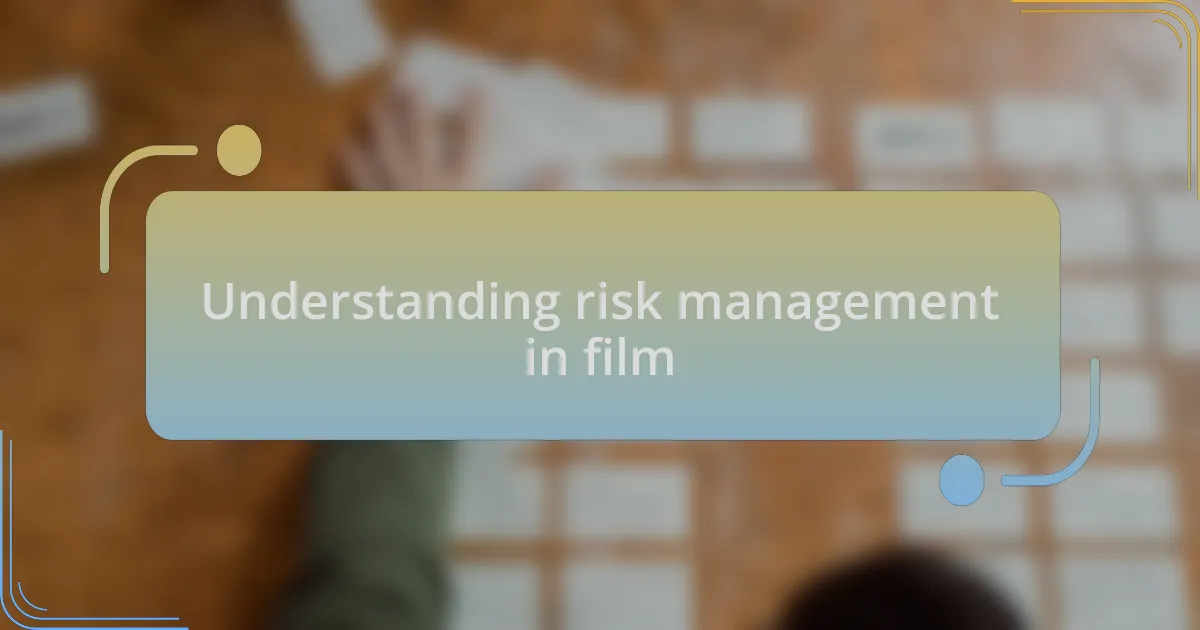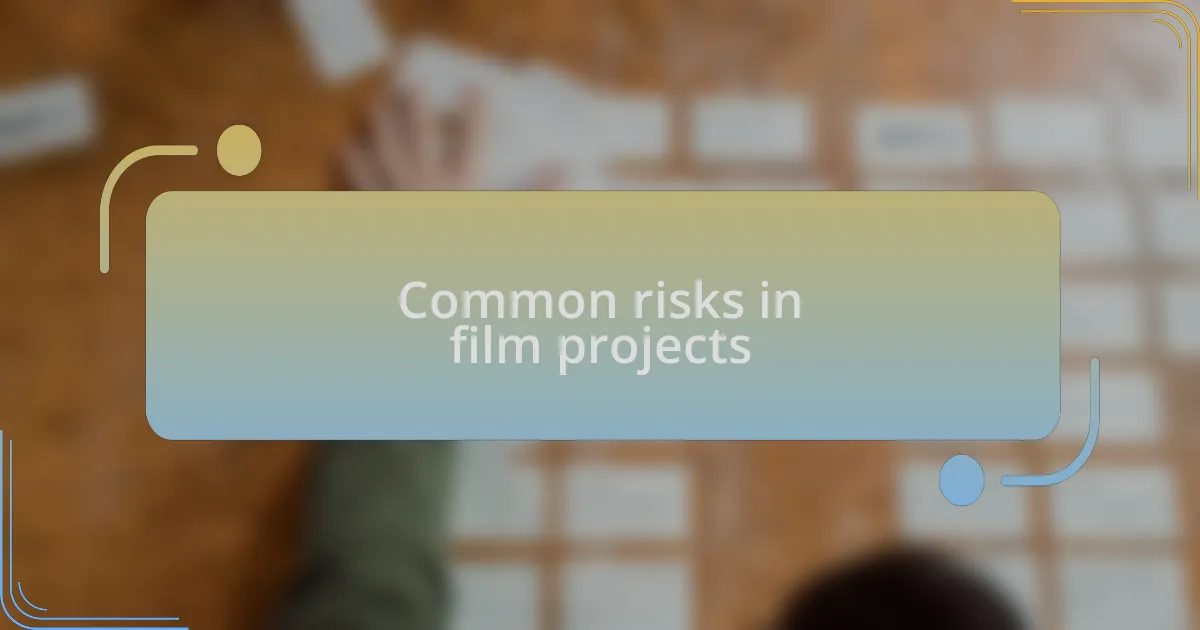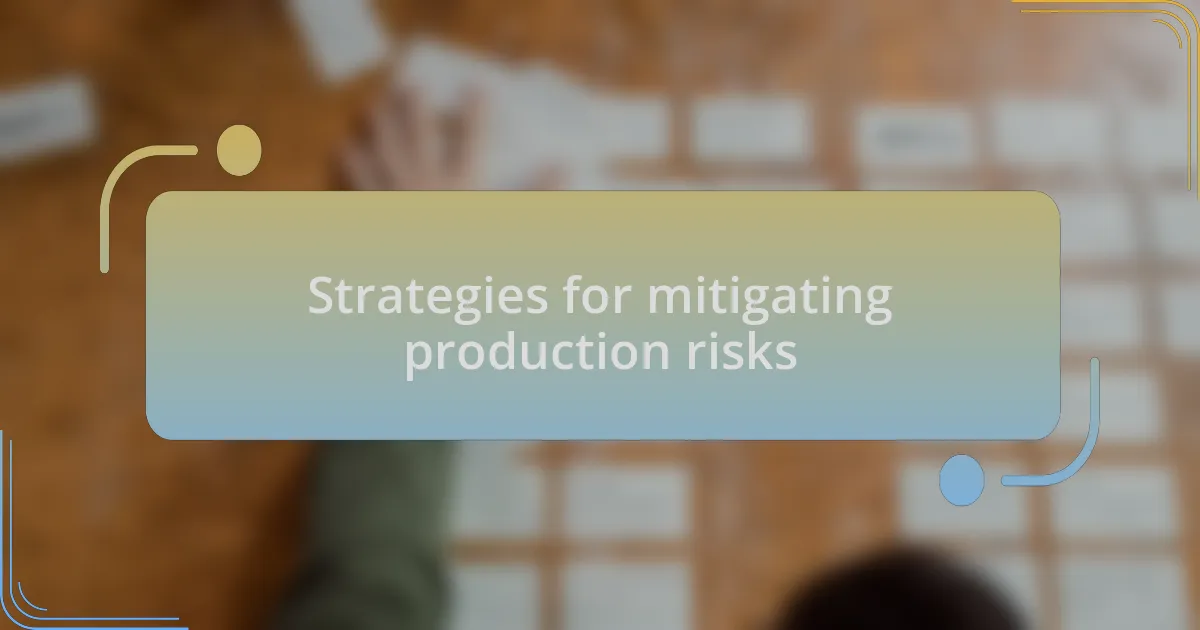Key takeaways:
- Risk management in film is crucial for navigating unforeseen challenges, ensuring the production stays on track.
- Proactive risk management fosters a positive team environment, enhancing creativity and collaboration.
- Common risks include losing locations, financial issues, and talent availability; planning for contingencies is essential.
- Adaptability and open communication are key strategies for mitigating risks and maintaining project momentum.

Understanding risk management in film
Risk management in film is not just a bureaucratic necessity; it’s an art form that ensures creative visions don’t falter under unforeseen pressures. Just think about it: when I was on set for a challenging scene, a sudden rainstorm threatened to derail an entire day’s work. By having a solid risk management plan, we quickly shifted our shooting schedule and implemented indoor alternatives, which kept the production flowing seamlessly.
When examining the various facets of production, it becomes clear that risk management is about anticipating the unpredictable. For instance, during a shoot on a tight budget, I learned the vital importance of having insurance—not just to protect equipment but to safeguard crew and talent as well. How often do we hear stories of accidents on set? These incidents underscore the necessity of planning for the unexpected, allowing creativity to thrive without looming fears.
Every production I’ve worked on has underscored a crucial lesson: proactive risk management fosters a healthy working environment. It encourages communication and teamwork, knowing that everyone has a stake in both the process and the outcome. In my experience, when the team feels secure, they can fully immerse themselves in their craft, enhancing not only their performance but also the overall quality of the project. What can be more rewarding than watching a team collaborate without fear, fully focused on bringing a story to life?

Common risks in film projects
When it comes to film projects, one of the most common risks I’ve encountered is the loss of crucial locations. There was a time when our primary filming location unexpectedly became unavailable just a week before our scheduled shoot. I remember the panic as we scrambled to find a substitute, realizing how vital location is to the story we want to tell. It drove home the importance of not only securing backup locations beforehand but also maintaining strong relationships with property owners.
Financial risks are another major concern in film production. I’ve seen budgets stretch thin as unforeseen expenses continuously pop up, whether it’s due to cast changes or equipment failures. This experience has taught me that a flexible budget strategy is essential. By allocating a contingency fund, you can navigate those obstacles without compromising your vision or losing morale among the team. How often have you seen a project stall because of financial mismanagement?
Then there’s the risk of talent issues. A few years back, a lead actor became unavailable due to a sudden conflict, forcing us to reconsider our entire casting strategy. This taught me the importance of having alternative actors in mind when casting and a clear communication plan in place. After all, when everyone is aligned, it helps to keep the project on track and the energy positive, making creative decisions feel less like a burden and more like an exciting challenge.

Strategies for mitigating production risks
One effective strategy I’ve found for mitigating production risks is establishing a thorough risk assessment plan. Early in my career, a production I was involved with faced potential weather disruptions. By identifying this risk ahead of time, we developed a detailed backup plan for every outdoor shoot, ensuring we were prepared to pivot quickly. How many times have you realized too late that a small oversight could derail substantial efforts?
Another approach I emphasize is fostering communication among all team members. During a project when we hit a snag with our script, open dialogue allowed us to address the issue collectively, ultimately improving the final product. I believe that creating an environment where everyone feels comfortable sharing concerns can lead to innovative solutions and a more resilient production. Have you ever experienced moments when a simple conversation turned an obstacle into an opportunity?
Finally, I advocate for regular training on risk management practices for the crew. In a past shoot, we provided a workshop on safety and emergency protocols, which not only prepared our team for potential hazards but also built trust and camaraderie. It’s amazing how proactive learning can transform a group into a cohesive unit that faces challenges head-on. Wouldn’t you agree that investing time in education pays off when the unexpected strikes?

Lessons learned from managing risks
One significant lesson I’ve learned from managing risks is the importance of adaptability. I recall a time during a critical shoot where an unexpected venue change threatened our entire timeline. By staying flexible and quickly orchestrating our resources, we not only salvaged the day but also produced some of our best work. It made me realize how vital it is for any production team to embrace change rather than fear it. Have you ever experienced a shift like that, where adaptability turned a potential disaster into an unexpected triumph?
Moreover, I’ve found that documenting lessons learned is invaluable. After a tough production plagued by equipment failures, I initiated a debriefing session where the crew reflected on what went wrong. This open discussion led to a shared collection of insights that we could reference in future projects. It’s remarkable how recording these experiences can build a foundation for better risk management down the road. Isn’t it fascinating how looking back can illuminate the path forward?
Finally, I’ve discovered that not every risk can be fully controlled, and that’s okay. I once worked on a film during a particularly volatile political climate, which created unanticipated safety concerns for our cast and crew. Acknowledging that uncertainty exists but prioritizing safety made for a more confident team. I believe there’s a lesson in accepting risks as part of the creative process; it can lead to unexpected paths that enrich the overall production. Have you found comfort in the unpredictable, knowing it can lead to valuable experiences?